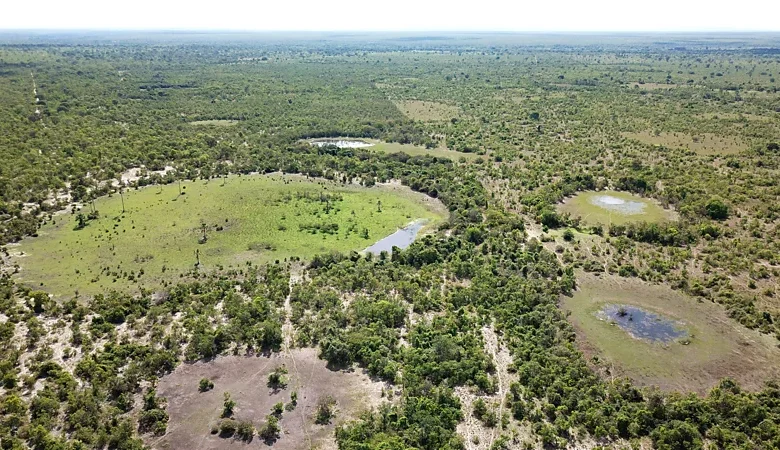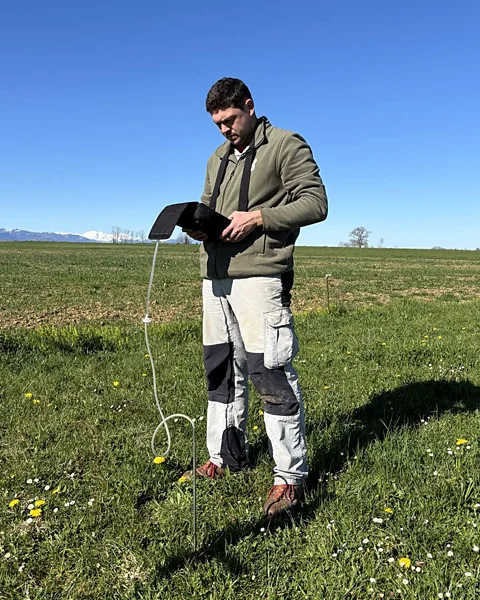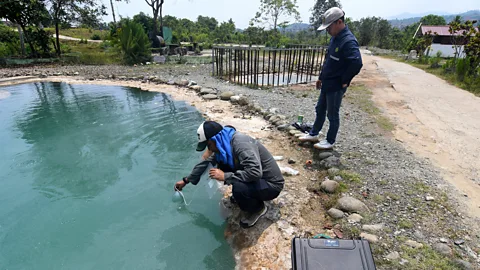The precious ‘white gold’ fuel buried in the Earth

Naturally occurring “white hydrogen” lies in vast reservoirs beneath our feet – now the gold rush of the clean energy era is beginning.
Investors had lost faith in Edwin Drake’s obsessive hunt for oil when the American entrepreneur finally struck black gold in an underground reservoir in Titusville, Pennsylvania, in 1859. The discovery spurred an exploration frenzy that launched the modern oil age.
Now, a new generation of wildcatters are racing to replicate that Titusville moment, hoping to bring about the dawn of a major new energy resource. However, it’s not fossil fuels they are looking for, but a commercially viable source of natural – and low-carbon – hydrogen.
Hydrogen, the smallest, simplest and lightest molecule on Earth, is currently used mainly for refining and chemical industries, such as producing ammonia for fertilisers. The vast majority of this hydrogen is made from polluting methane gas or coal gasification.
But there are already other, lower-carbon ways to produce hydrogen. And hydrogen’s ability to store three times more energy than oil, while only producing water when burnt, has made some view it as an attractive clean fuel option, especially for industries which are hard to decarbonise by electrification, such as aviation, shipping or steel production.
“Green” hydrogen, for example, is a cleaner alternative made by splitting water between hydrogen and oxygen molecules in a process powered by renewable energy. “Blue” hydrogen, made from fossil fuels using carbon capture and storage to reduce the emissions, is another alternative.
If just 2% of estimated levels of natural hydrogen was recoverable, it could meet projected global hydrogen demand for around 200 years, according to the USGS
Green and blue hydrogen have received huge attention as potential low-carbon fuels in recent years, but they also have significant downsides. Both are expensive and faced challenges and delays in their rollout. And while their use is slowly growing, together they still only make up around 1% of global hydrogen production. Some researchers have also raised doubts over how low-carbon blue hydrogen really is due to associated leaks of methane – a potent greenhouse gas which is 80 times more powerful than carbon dioxide (CO2) over a 20-year time span.
Meanwhile, in recent years scientists have found that naturally occurring hydrogen is actually much more widespread than previously thought, leading some to believe it could be tapped as a cheap and carbon-free fuel.
This “geologic” hydrogen, also called natural or white hydrogen, is produced naturally when underground water encounters iron-rich rocks in a process known as serpentinisation. Because hydrogen is so light, it usually seeps through porous rocks and cracks, eventually rising to the atmosphere. That’s if it isn’t first consumed in underground reactions or eaten by subterranean microbes.
But in some geological settings, hydrogen can become trapped under rocks with low permeability, such as salt or shale rocks, which create a seal under which the gas can accumulate. It’s these hydrogen accumulations in the Earth’s subsurface that prospectors hope may be viable for commercial exploitation.
According to a 2024 study from the US Geological Survey (USGS), there could be anywhere between one billion and 10 trillion tonnes of hydrogen in the subsurface, with a best guess of around 5.6 trillion tonnes trapped in geological formations.

Most of this hydrogen is likely to be “in accumulations that are too deep, too far offshore, or too small to be economically recovered”, the study’s authors, USGS geologists Geoffrey Ellis and Sarah Gelman, wrote. However, if just 2% of this white hydrogen was recoverable, it could meet projected global hydrogen demand for around 200 years, they found. It would also, they added, contain roughly twice as much energy as is stored in all the proven natural gas reserves on Earth.
The idea has sparked huge interest in what could be lying under our feet. At least 60 companies have publicly said they are exploring for white hydrogen, with investment estimated to have reached $1bn (£740m), says Eric Gaucher, a French geochemist who co-leads a white hydrogen expert group convened by the International Energy Agency (IEA).
The hope is to make a big discovery in the next three or four years. My dream is that this natural hydrogen can play a role, maybe as oil played in the past – Eric Gaucher
Prospectors like Gaucher argue the discovery of a commercially viable hydrogen reservoir could usher in a new age of exploration in the same way that Drake’s 1859 find fired the starting gun for the oil economy. “The hope is to make a big discovery in the next three or four years,” he says. “My dream is that this natural hydrogen can play a role, maybe as oil played in the past.”
Still, Gaucher admits prospectors should currently remain “modest” about white hydrogen’s potential role in the energy transition. Not least because huge uncertainties remain about how much of it could actually be recoverable from the Earth’s mantle.
“Currently, we really have no idea,” says Ellis, of the USGS. “That’s the big question. From what we know today, there’s just too much uncertainty to really make any predictions about how impactful [natural hydrogen] might be.”
The only place where white hydrogen extracted from the Earth is currently used is in the village of Bourakebougou in western Mali. The local community’s fate changed in 1987 when the cigarette of a worker digging a water well sparked a small explosion as he leaned over the edge. Nearly pure hydrogen was later found at the bottom of the borehole. It is now used to produce electricity for the village.
Odourless, colourless and tasteless, hydrogen is difficult to detect without specifically looking for it. But in early 2025, a team of geologists announced they found a clue for where to start looking.
Using simulations of plate tectonic processes, they showed that rocks that had been pushed closer to the surface during the formation of mountains could be hotspots for white hydrogen. The researchers identified mountain ranges stretching from the Alps to the Himalayas as possible targets for exploration.
Other researchers in the UK and Canada recently published a list of key ingredients needed to find hydrogen-producing underground systems. “We know for example that underground microbes readily feast on hydrogen,” study co-author Barbara Sherwood Lollar, a professor of geology at the University of Toronto, said in a release. “Avoiding environments that bring them into contact with the hydrogen is important in preserving hydrogen in economic accumulations.”

Although exploration of white hydrogen has been gathering steam, no commercially viable wells have yet been found. In its 2024 global hydrogen review, the IEA described white hydrogen production technology as scoring five out of nine on its technology readiness scale.
There is also still insufficient evidence to prove white hydrogen is even a renewable resource for use at scale, says Laurent Truche, a professor of geochemistry at Grenoble Alpes University in France who researches natural hydrogen. That’s because it’s not clear whether or not hydrogen is generated quickly enough to replace any that might be extracted from reservoirs. Truche says the rate of hydrogen generation is “several orders of magnitude too slow compared to what we would expect to produce”.
He worries about the hype, noting that “natural hydrogen production is currently tiny, the hydrogen that is found is rarely pure, [and] many discoveries are of dissolved gas, which is difficult to produce”.
Even if a large discovery was made in the next few years, it would take at least another decade to develop an industry at scale – Laurent Truche
Naturally produced hydrogen is also unlikely to be located where it is needed and hydrogen is difficult to transport and store, although proponents said it could support fuel sovereignty by powering local industries.
But extracting white hydrogen could also come with unintended consequences, including impacts on the climate that could undo some of the benefits of replacing fossil fuels.
Hydrogen reservoirs can contain methane, which could offset the benefits of white hydrogen unless it were captured. What’s more, once in the atmosphere, hydrogen competes with methane for hydroxyl, a compound which breaks down methane molecules. This means that any hydrogen that escapes during extraction would also make methane in the atmosphere last longer and cause even more warming.
These methane emissions, alongside the emissions embedded in drilling infrastructure, mean white hydrogen production wouldn’t be totally carbon free.
One initial estimate suggests that, in cases where reservoirs have a high percentage of hydrogen and low amounts of methane, 0.4kg of CO2 equivalent (CO2e) would be emitted for every kilogram of hydrogen produced. That’s less than the average 1.6kg CO2e generated with each kilogram of green hydrogen, which requires the construction of vast renewable energy infrastructure.
However, emissions associated with white hydrogen production would increase the more methane is in the reservoir and the less productive the well becomes. A well with 75% hydrogen and 22.5% methane would emit 1.5 kg CO2e per kg of hydrogen, according to the same study.
White hydrogen proponents said that methane emissions can be filtered, while extracting and burning hydrogen as a fuel would reduce the amount that naturally leaks to the surface and reaches the atmosphere.
But Truche disagrees. Large-scale white hydrogen production would lead to increased hydrogen leakage into the atmosphere, he says. It could also impact underground ecosystems and the microbial life that rely on hydrogen as an energy source, he adds. These microbes play an important role in the cycle of the Earth’s chemical elements and compounds – yet relatively little is known about the deep terrestrial subsurface, according to a scientific review by Rachel Beaver and Josh Neufeld at the University of Waterloo in Canada.

Even if a large discovery was made in the next few years, it would take at least another decade to develop an industry at scale, says Truche, meaning white hydrogen will not have an impact on the energy system anytime soon.
Other experts have also argued white hydrogen extraction “simply won’t be available” to replace the fossil fuel-produced hydrogen currently in use within the timeframe needed to meet global climate goals.
For Emmanuel Masini, founder and chief executive of Mantle8, a French hydrogen exploration start-up backed by Bill Gates’ Breakthrough Energy, however, the urgent need for decarbonisation is exactly the reason for accelerating white hydrogen exploration.
“We are convinced there could be really significant [hydrogen] reserves, we need to go ahead and deliver them,” Masini says.
To do this, Mantle8 has developed a technology which uses geology, geophysics and geochemistry data and sensors to create 4D images (in three dimensions and across time) of the Earth’s mantle to pinpoint the specific location of white hydrogen reservoirs and quantify and monitor the volume of hydrogen in each.
The technology could be used to map the entire planet and take out the guesswork in exploration by identifying replenishing reservoirs, saving both time and money, says the start-up. Masini says it has already identified 12 promising locations across Europe and aims to identify 10 million tonnes of hydrogen reserves by 2030 – a goal he is confident it can meet.









